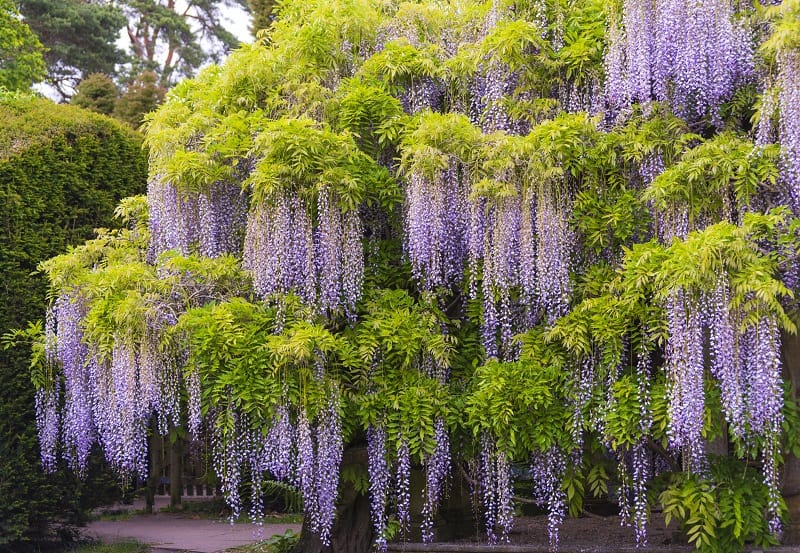
Wisteria is a flowering plant of the legume family Fabaceae, which includes ten species of vine. These plants are native to Korea, Japan, China, southern Canada and the eastern United States. They are fast-growing and are considered invasive. They bloom in spring and produce clusters of fragrant, lilac-colored flowers, but also suffer their share of conditions that cause yellowing leaves.
Wisteria leaves turning yellow: What are the reasons?
Normal yellowing due to seasonal changes
Wisteria plants, specifically the Japanese and Chinese wisteria varieties, are deciduous, woody vines commonly grown in the USA. When the young leaves appear in springtime, they are naturally yellow and will remain so for a few weeks. The leaves will eventually turn deep green as the season progresses.
Wisteria leaves will also turn yellow when cool weather arrives in fall and leaflets may drop off the plants. This is normal as winter approaches. Yellow leaves early in spring and older leaves turning yellow during fall are natural occurrences and reflect seasonal changes, so there is nothing to worry about at all.
Fungal infections
Wisteria leaves turning yellow could be attributed to fungal infections. Powdery mildew causes yellowish mottling during summer when the weather is warm. This fungal disease is caused by species of fungi of the order Erysiphales.
Cankers are a fungal disorder that causes leaves to turn yellow and wilt. The branches may also develop dark, soft spots.
To treat these disorders, you need to prune all the affected plant parts. Sterilize the pruning blades in rubbing alcohol between cuts to avoid spreading the infection. Water the plants with a soaker hose or drip irrigation to keep the foliage dry and clear plant debris from under the plants.
Insects or pests
Wisteria plants attract pests like aphids and scale insects which suck on the sap or juice of the plant, resulting in yellowing leaves. Aphids are soft-bodied, yellowish-white pests that produce a sticky fluid called honeydew. Scale insects are hard-bodied pests that resemble raised and dark spots on stems and leaves. They damage the foliage and cause leaves to turn yellow and fall off.
To exterminate these pests, spray the affected plant parts with insecticidal soaps, neem oil or horticultural oils.
Viruses
Wisteria leaves may also turn yellow due to plant viruses like the tobacco mosaic virus. This viral infection causes yellow streaks or spots on the leaves, although they may look healthy. Viral infections usually do not do significant damage, but you should provide your plants with consistent moisture if they are affected, to prevent further stress. Make sure the plants get about one inch of water weekly.
Iron deficiency
Another reason wisteria leaves turn yellow is due to iron deficiency in the soil. The roots cannot absorb nutrients if iron is deficient, and if the soil pH is alkaline as opposed to the neutral to slightly acidic soil that these plants prefer.
To fix the issue, use a soil test kit to check the soil’s nutrient content and amend with the addition of compost or peat.
Poor drainage
Yellowing wisteria leaves could be due to poor drainage. Excess moisture from overly soggy soil spells danger for wisteria plants and the leaves will turn yellow and fall off.
Fix this problem by checking the drainage of your garden or planters and hold off watering until you can achieve the necessary porosity.
Wisteria plant care
- During springtime, apply a layer of compost under the soil and at least a two-inch layer of mulch to control weeds and retain moisture.
- Provide phosphorus to aid with flowering.
- Make sure to water the plants if there is less than one inch of rain each week.
- Cut back the rampant shoots every two weeks during summer to encourage more blooms.
- Plant wisteria during the spring or fall while they are dormant.
- It is ideal to buy established plants or start from cuttings, but they can also be grown from seed, although it may take a few years for them to mature and produce flowers.
Conclusion
Wisteria plants are popular for their fragrant, lilac-colored flowers but, like most plants, they also suffer their share of disorders that cause yellowing leaves. This could be due to fungal or viral infections, seasonal changes, iron deficiency, pests, or poor drainage.
Image: istockphoto.com / allou